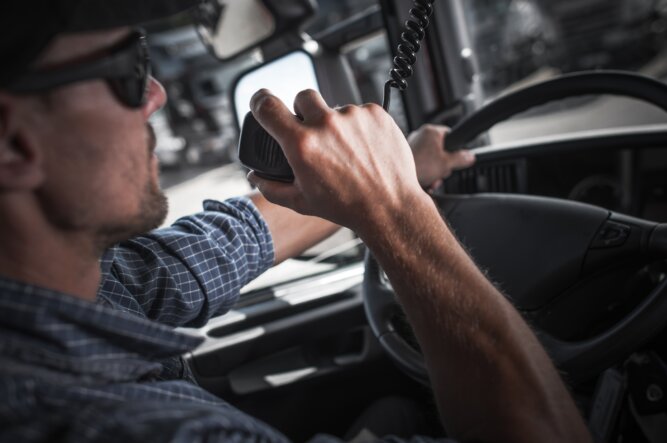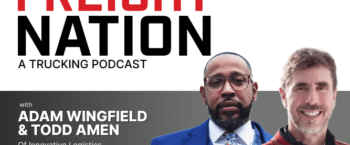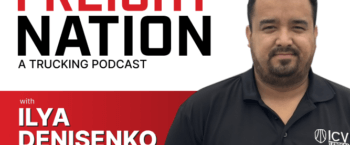How to Get a Commercial Driver’s License (CDL)

Listen up!
Check out our podcast, Freight Nation, where industry experts talk all things trucking.
Driving a commercial truck is much different than driving a regular motor vehicle. So before you get started, you’ll need to verify you’ve completed specialized training and tests by obtaining your CDL (commercial driver’s license).
To get a CDL, you’ll have to pass a general knowledge written test and a series of driving skills tests. The Federal Motor Carrier Safety Administration (FMCSA) sets requirements for CDLs, but your state may have additional requirements for getting a CDL.
In this post, we’ll explain the six steps for getting a CDL and how to make sure you’re prepared for your exam.
The 6-step process for getting your CDL
Ready to get your CDL? Follow these six steps:
1. Get a CDL manual.
Each state has its own CDL manual. Visit your state’s official transportation website for a copy, and check out the specifics for CDL skills testing in your area.
2. Decide what kind of driving you’ll be doing.
Licenses are issued depending upon the commercial vehicle and type of driving you’ll be doing, and some drivers will need special endorsements if operating certain types of commercial vehicles. For example, if you’re going to move hazardous materials, you need a hazardous materials endorsement which requires an additional knowledge test. (The full list of endorsements and restrictions is available on the FMCSA website).
3. Figure out the class of CDL you’ll need.
This determines the type of testing you’ll have to prepare for.
The FMCSA designates three different classes of commercial vehicles. Your CDL is issued according to these classifications:
- Class A: Combination vehicle. Any combination of vehicles with a gross combination weight rating (GCWR) or gross combination weight of 26,001 pounds or more, whichever is greater, if the towed vehicle weighs more than 10,000 pounds. Class A vehicles include tractor-trailers, flatbeds, and livestock carriers.
- Class B: Heavy straight vehicle. Any vehicle with a gross vehicle weight rating or gross vehicle weight of 26,001 pounds or more, or any vehicle towing a vehicle weighing 10,000 pounds or less. Class B vehicles include school buses, box trucks, and dump trucks with trailers.
Class C: Small vehicle. Any single vehicle, or combination of vehicles, that doesn’t meet the definition of Class A or Class B, but is either designed to transport 16 or more passengers, including the driver, or is transporting material that has been designated as hazardous under federal law. Class C vehicles include shuttle vans and small hazmat tankers.
4. Get your commercial learner’s permit (CLP).
A commercial learner’s permit allows you to drive as long as you have someone with a qualified CDL in the cab with you. CLPs are issued by the state you live in according to the standards established by the FMCSA. Those standards are:
- A valid non-commercial driver’s license issued by the state you live in.
- At least 18 years old for an intrastate CLP or at least 21 for an interstate CLP. (Drivers who are 18, 19, or 20 may qualify for an interstate CLP if they apply through an approved member of the Safe Driver Apprenticeship Pilot Program).
- Proof of citizenship or lawful permanent residency (Social Security card, birth certificate, etc.)
- Pass applicable background screenings.
- The names of all the states in which you’ve been licensed to operate a motor vehicle of any kind over the past 10 years.
- No active driver’s license suspensions or revocations.
- Not subject to any disqualifications under FMCSA regulations or state law.
- Not having a driver’s license from more than one state or jurisdiction.
- Speak and read English (state exams are in English only).
5. Complete your entry-level driver training (ELDT)
All first-time CDL applicants must complete entry-level driver training before taking the CDL exam. See the FMCSA training provider registry to find a trainer.
There’s no minimum training hours requirement — “successful” completion of training is at the discretion of the trainer. But drivers must complete road and range training, including parallel parking and straight-line backing maneuvers.
If you want to earn money while mastering your driving skills, there are many companies that offer truck driver training for new hires who agree to work for them for 1-2 years. However, if you find such an opportunity and quit your job prematurely, you’ll have to reimburse the company for the cost of the training, which could be costlier than partnering with an individual trainer.
6. Take your CDL exam.
Once you complete your training, you can apply for your CDL if you’ve had your CLP for at least 14 days. If you’re planning to drive a Class A truck across state lines, you’ll also need a medical examiner’s (ME) certificate before you can take your exam.
The certificate must be provided by the Department of Transportation (DOT), and someone on the National Registry of Certified Medical Examiners must complete the exam.
Drivers must provide a copy of their ME certificate (DOT medical card) to their State Driver Licensing Agency (SDLA) and certify which type of vehicle they expect to operate.
Federal requirements for CDL skills tests include:
- Vehicle inspection test
- Basic controls test
- Road (driving) test
The FMCSA is also considering a rule that would require new drivers to pass a standardized written test.
States may have additional requirements — such as a vision test, driving skills test, or written test. You may be able to find state-specific practice tests online.
Start your career with Truckstop
Once you have your valid CDL, it’s time to hit the road!
If you decide being an owner-operator is on your radar, Truckstop is here to support you with tools and resources. We can make finding loads easier for the long haul.

Find out how our platform gives you the visibility you need to get more done.
Get helpful content delivered to your inbox.
Schedule a demo.
Find out how our platform gives you the visibility you need to get more done.





